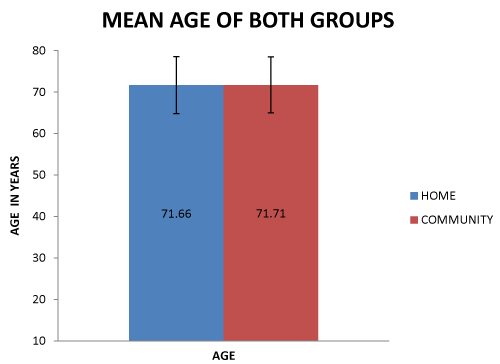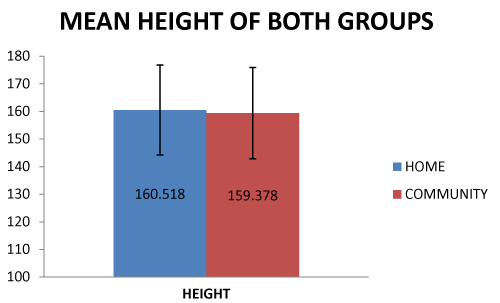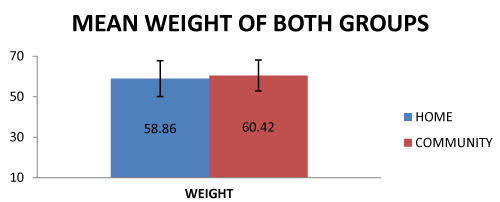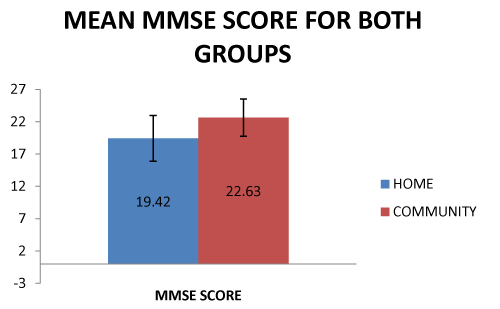| Research Article |
Open Access |
|
| Sethi Vanshika* and Shukla kritika |
| Section incharge, Department of Physiotherapy, Saaii College of Medical Science and Technology, Research Scholar, Singhania University, India |
| *Corresponding authors: |
Vanshika Sethi
Section incharge and Lecturer
Department of Physiotherapy
Saaii College of Medical Science and Technology, Research Scholar Singhania University, India
E-mail: sethivanshika@gmail.com |
|
| |
| Received June 06, 2012; Published July 27, 2012 |
| |
| Citation: Vanshika S, Kritika S (2012) Comparison of Cognitive status of Elderly People Living in Old Age Home and in Community on MMSE. 1: 216. doi:10.4172/scientificreports.216 |
| |
| Copyright: © 2012 Vanshika S, et al. This is an open-access article distributed under the terms of the Creative Commons Attribution License, which permits unrestricted use, distribution, and reproduction in any medium, provided the original author and source are credited. |
| |
| Introduction |
| |
| Increasing life expectancy and demographic changes are causing the absolute number of elderly people to increase as well as their proportion of the total population. Because of this, maintaining cognitive function and emotional well-being in the last decades of life becomes an important topic for our society. It is well known that some cognitive functions decline in older age, mainly fluid intelligence components such as perceptual speed and working memory capacity; other cognitive function stay stable over along period in life, such as verbal fluency and knowledge representations Today it is well accepted that there are domain-general as well as function specific-mechanisms which explain the cognitive and sensory decline that occurs in old age [1]. |
| |
| Much research has been done to investigate how cognitive functions remain stable over long periods of time. Correlation studies suggest that older people who are physically, emotionally, and socially engaged are at less risk to suffer from dementia than older adults who do not engage in such activities conducted an investigation with1, 750 older adults, performing tests every 2 years over a period of 6years.They showed that people who are physically active at least three times a week had a minor probability for suffering from dementia .But if other factors were included in the analysis, for example smoking and education level, this advantage was reduced [1]. |
| |
| Problems for Elderly People |
| |
| Delirium is common and deadly in older adults with dementia, and is often referred to as delirium superimposed on dementia, DSD. Over 80% of older adults with dementia experience delirium when hospitalized, and studies report that between 24 and 76% die within one year of the index episode [2]. |
| |
| Voyer and colleagues found that advanced age, dementia severity, pain, depression, dehydration, function, behavior, number of medications, and fever were all predisposing risk factors for DSD patients with Alzheimer’s Disease (AD), Urinary Tract Infection (UTI), surgery, stress/bereavement (death of spouse, change in residence), and severe pain occurred more frequently in delirious than non-delirious patients. Using administrative data, our retrospective review of 7,347 persons with dementia found that those with DSD were older and treated for higher rates of cerebrovascular disease, UTI, dehydration, and pneumonia. Severity of delirium has been linked to later stages of dementia and presence of depression [2]. |
| |
| Memory |
| |
| Memory difficulty is one of the most common complaints of older adults so the study of age-related changes in memory function is motivated by practical as well as theoretical considerations ,the four theoretical approaches are a decline in processing speed, reduced processing resources, age-related inhibitory deficits, and decreased cognitive control. The slowing of behavior in old age is widely accepted and well documented [3]. |
| |
| Memory is commonly divided into |
| |
| Short-term memory/working memory |
| |
| The classic distinction between short-term and long-term memory, featured in Atkinson and Shiffrin’s model (1968), gives a good account of the dissociations described in amnesic syndromes [4]. |
| |
| Long-term memory |
| |
| Episodic memory is defined as the memory of personallyexperienced events, situated in the temporal-spatial context of their acquisition. This concept of episodic memory has been undergoing profound and continuous change until recently [4]. |
| |
| Memory Loss |
| |
| Advanced age is associated with significantly reduced performance on episodic memory tasks, such as list recall, paired-associate learning, and prose recall. Age differences in recall and recognition are observed in laboratory and naturalistic settings, and in cross-sectional and longitudinal studies. However, the mechanisms that mediate agerelated declines in episodic memory are not well understood [5]. |
| |
| As in elderly people changes in the memory with age is a significant problem affecting their day to day routine activities & there by decrease their efficiency so assessment of memory & its comparison in elderly people living in old age home & community forms the basis of this study. |
| |
| Review of Literature |
| |
| Head Denise et al. in their study on “Neuroanatomical and Cognitive Mediators of Age-Related Differences in Episodic Memory” in July2008 have suggested a path analysis framework to explore the mediating role of differences in brain structure, executive functions, and processing speed in age-related differences in episodic memory [5]. |
| |
| Glisky L. Elizabeth and Kong L. Lauren in their study on “Do Young and Older Adults Rely on Different Processes in Source Memory Tasks? A Neuropsychological Study” in July 2008 has indicated that the frontal composite, which has consistently been associated with source memory performance in older adults, was unrelated to source memory in young adults, although it was sensitive to a demanding working memory task [6]. |
| |
| Lineweaver T. Tara et al. [7] in their study on “Expectations about Memory Change across the Life Span Are Impacted by Aging Stereotypes” in March 2009 have examined whether expectations about memory change with age vary for different personality types. Older participants were more strongly influenced by both the valence and the relevance of the personality descriptions than younger participants. Their results expand the previous literature on beliefs about aging and memory by demonstrating that expectations about age-related memory change vary when applied to different types of individuals. |
| |
| Karlsgoldt et al. [8] in their study on “A Multimodal Assessment of the Genetic Control over Working Memory” in June 2010 have suggested that genetic contributions to both working memory performance and to neuroimagning measures focused on the network of brain regions associated with working memory. Their Analyses directly addressed whether working memory performance and neural structural integrity are influenced by common genetic factors. |
| |
| The Mini-mental status examination is among the most commonly used screening tests for evaluating the cognitive status in clinical practice and research [9]. |
| |
| Methodology/Procedure |
| |
| Design |
| |
| This study is a survey type study which intended to find the effect of changes in level of memory in subjects living in community &old age home. |
| |
| Sample |
| |
| |
| A sample of 200 subjects (100 from old age home & 100 from community i.e. group-a & group-b) elderly subjects of sixty & above years of age were taken by convenient sampling method, they were collected through various old age home which include, Baikunth dham old age home, Ishwar prem ashram, swaraj ashram, & Ramkrishna mission located in Kanpur & Varanasi and nearby community. |
| |
| All subjects signed a consent form & were ready to take part in the study. The subjects were given the instructions regarding the procedure & the subjects who full fill the inclusion criteria & were ready to actively participate were selected. |
| |
| Inclusion criteria |
| |
| 1. Normal elderly - Male & Female with age of more than and equal to 60 year from old age home & community. |
| |
| 2. Able to understand verbal instructions & completed 8 to10 year of formal education. |
| |
| 3. Subjects with stable medication. |
| |
| Exclusion criteria |
| |
| 1. Any neurological problem such as Parkinson’s disease, cerebral disorder, balance disorder, myopathy, mylopathy etc which can influence psychological status of the subjects. |
| |
| 2. Any cardiovascular disease or orthopaedic problems which affect their day to day routine activities & further which can become the cause of depression. |
| |
| 3. Significant hearing & vision impairment |
| |
| 4. Uncontrolled hypertension. |
| |
| 5. Any speech deficit interfering the survey. |
| |
| 6. Unstable seizure disorder interfering study |
| |
| 7. Smoking or alcohol intake. |
| |
| Procedure |
| |
| The subjects were introduced to the study followed by signing of consent form, general assessment regarding the socio-demographic data(name, gender, age , education level ,past medical history, & personal history, family history were gathered in participants assessment form and subjects were collected from various old age home & community & were divided into two group-a & group- b for comparison & total 100 number of subjects data was collected in each group i.e. group-‘a’ for old age home & group-‘b’ for community . The subjects were assigned a number to maintain the confidentiality of subjects & then the scale was used to assess the scores i.e. mini-mental status examination, the scale used to check the level of memory loss & the score was entered in data collection form. |
| |
| Outcome measures |
| |
| Readings on mini-mental status examination scale were taken during first contact interview with the subject and were calculated as data. |
| |
| Results |
| |
| After assessing the demographic detail including age, gender, height, weight these variables were summarized by mean & standard deviation for two groups. Student t-test was applied to compare the difference in age, height and weight & education level between two groups. |
| |
|
|
Table 1: Analysis of age between group ‘a’ & group ‘b’. |
|
| |
|
|
Table 2: Analysis of height between group ‘a’ & group ‘b’. |
|
| |
|
|
Table 3: Analysis of weight between group ‘a’ & group ‘b’. |
|
| |
|
|
Table 4: Analysis of mini-mental status examination score between group ‘a’ & group ‘b’. |
|
| |
| Independent t-test was applied to compare the data, mini-mental status examination score in between two groups i.e. group-‘a’ for old age home and group ‘b’ for community and the scores were compared for mini-mental status examination (MMSE). SPSS version 12.0 was used for data analysis and in this study p value of less than and equal to (≤) 0.05 has been considered as statistical significant. |
| |
|
|
Figure 1: Comparison of age between group ‘a’ & group ‘b’. |
|
| |
|
|
Figure 2: Comparison of height between group ‘a’ & group ‘b’. |
|
| |
|
|
Figure 3: Comparison of weight between group ‘a’ & group ‘b’ . |
|
| |
|
|
Figure 4: Comparison of mini-mental status examination score between group ‘a’ & group ‘b’. |
|
| |
| Our aim of doing this study was to find out the difference in the level of memory in normal subjects living in old age home and in community, which were divided into group ‘a’ and group ‘b’. The result of mean score on mini-mental state examination showed significant difference in between the groups i.e. the mean score of mini-mental state examination was 19.42 with s.d.value 3.522 in group ‘a’ living old age home and 22.63 with s.d.value of 2.894 in group ‘b’ living in community, on comparing, p value is 0.000* which shows there is significant difference in Mini-mental Status examination scores. Hence level of memory is affected in subjects living in old age home more than subjects living in community. |
| |
| Therefore older adults may need to use more deliberate internal mnemonics and external aids to ensure successful remembering. Doing so could lead to equivalent functional memory performance despite age changes in the effectiveness of cognitive mechanisms supporting incidental memory [10]. |
| |
| Conclusion and Discussion |
| |
| Results of the study shows the memory in elderly living in old age home is more affected than individuals living in community therefore following are the suggested activities for effective rehabilitation of memory loss and to increase their day today routine efficiency. |
| |
| As literature suggests that the societal implications of helping older individuals with dementia regain adequate function after hospitalization in order to return to their homes are enormous in terms of ageing in place, quality of life, cost, and caregiver burden, therefore a positive rehabilitation program may be designed to enhance their memory in old age home [11]. |
| |
| It has been shown that increased engagement seems to have improved the emotional well being of the participants and is in line with studies which found reduced depression rates for physically active older people, therefore foremost goal and priority should be to engage elderly people in goal/task oriented activities [1]. |
| |
| It has been shown that any activity which is performed in a group seems to have a benefit on the emotional parameters of older people; therefore group interaction should be an important part of day today routine activities in old age home [2]. |
| |
| |
| References |
| |
- Jansen Petra, Dahmen-Zimmer K (2012) Effects of cognitive, motor, and karate training on cognitive functioning and emotional well-being of elderly people. Front Psychol 3: 40.
- Kolanowski AM, Fick DM, Litaker MS, Clare L, Leslie D, et al. (2011) Study protocol for the recreational stimulation for elders as a vehicle to resolve delirium superimposed on dementia (Reserve For DSD) trial. Trials 12: 119.
- Kester JD, Benjamin AS, Castel AD, Craik FIM (2002) Memory in elderly people, Handbook of memory disorder. (2nd edn) wiley, London.
- Eustache F, Desgranges B (2008) MNESIS: towards the integration of current multisystem models of memory. Neuropsychol Rev 18: 53-69.
- Head D, Rodrigue KM, Kennedy KM, Raz N (2008) Neuroanatomical and Cognitive Mediators of Age-Related Differences in episodic memory. Neuropsychology 22: 491-507.
- Glisky EL, Kong LL (2008) Do Young and Older Adults Rely on Different Processes in Source Memory Tasks A Neuropsychological Study. J Exp Psychol Learn Mem Cogn 34: 809-822.
- Lineweaver TT, Berger AK, Hertzog C (2009) Expectations about Memory Change Across the Life Span Are Impacted By Aging Stereotypes. Psychol Aging 24: 169-176.
- Karlsgodt KH, Kochunov P, Winkler AM, Laird AR, Almasy L, et al. (2010) A Multimodal Assessment of the Genetic Control over Working Memory. J Neurosci 30: 8197–8202.
- Freidl W, Schmidt R, Stronegger WJ, Irmler A, Reinhart B, et al. (1996) Mini mental state examination: influence of socio demographic, environmental & behavioral factors &vascular risk factors. J Clin Epidemiol 49: 73-78.
- Hertzog C, McGuire CL, Horhota M, Jopp D (2010) Does believing in “use it or lose it” relate to self-rated memory control, strategy use and recall. Int J Aging Hum Dev 70: 61-87.
- Mather M, Schoeke A (2011) Positive outcomes enhance incidental learning for both younger and older adults. Front Neurosci 5: 129.
|
| |
| |




